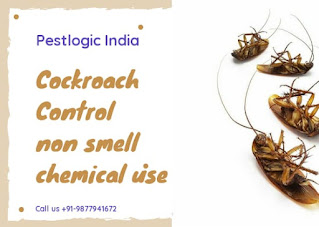Pest Management- Use of Certified Pesticides
Pest Management- Use of Certified Pesticides

Vikas K Kalsyan
(Microbiologist)
9877941672, 9411644142
Branch office- Mohali, Karnal , Dehli
What is Pest
Organism injurious to mankind [Flora & fauna, animals (pets or other-wise), articles of use luxury
or life style etc.]
Main consideration-Economic injury level
Main types of pests
Insects
Flying (adult moths / flies & larvae)
Crawling (beetles / weevils / cockroaches)
Rodents
Mice (field / house)
Rats (roof / Norway)
Birds
Pigeons / crows / starlings / gulls
Other mammals
Pests attacking foodgrains
Insects
Flying (adult moths / flies & larvae)
Crawling (beetles / weevils / cockroaches)
Rodents
Mice (field / house)
Rats (roof / Norway)
Birds
Pigeons / crows
Micro organisms
Fungi, Bacteria etc.
Management
Management means- to contain (restrict) below economic injury level.
Control means- Elimination
Management Options:
Cultural- Behavioral- Sanitation & Hygiene-
Environmental Manipulation
Mechanical
Chemical
Discussion on these aspects will be in relation to pests of
foodgrains
Cultural: Mechanical
Prophylactic and Curative Treatments
The crawling insect infestation in the warehouses/godowns is
controlled by spraying effective prophylactic chemicals such as
Malathion 50% EC and Deltamethrin 2.5% WP at recommended
doses on walls, floor, alleyways and surface grain bags. Malathion
50% EC is diluted with water in the ratio of 1 : 100 and 3 liters
emulsion is sprayed on 100 sq. mtr. surface area after 15 days
interval. Similarly, 40 gms. of deltamethrin 2.5% WP is dissolved
in 1 liter of water and 3 liters emulsion is sprayed on 100 sq. mtr.
surface area after 90 days.
Under curative control measures, the insects are eliminated by
using fumigants like Methyl bromide and Aluminium phosphide
(phosphine) at recommended doses in a closed air tight storage
system or under gas proof fumigation covers.
Stored grain insect pests and their control
Stored grain insect pests cause, both
quantitative and qualitative losses, during
storage of foodgrains. At high moisture their
growth and multiplication is very fast. The
optimum conditions of temperature and
relative humidity for the rapid growth and
multiplication of stored grain insect pests
range from 25 to 35 degree Celsius and 60 to
65% respectively.
Stored grain insect pests also contaminate the
foodgrains with harmful and unhygienic
materials like uric acid which causes
rheumatic pain in human beings.
Qualitative and Quantitative losses to
foodgrains need to be considered.
Is that appropriate to let the foodgrains
spoiled?
Prophylactic treatment
These are necessary for maintaining the health of the grain during
storage. They serve to prevent cross infestation and also to control
sudden rise in infestation. If, pest free foodgrain stocks are stored
under cool and dry conditions in a clean well aerated godown, the
stocks can be kept without fumigation by resorting to prophylactic or
surface treatments only.
The chemicals normally used for prophylactic treatments are
Malathion, Deltamethrin & DDVP.
Brushing of bags before spraying makes the insecticide used
relatively effective and long lasting.
Godowns should be kept open as required for operations, inspections
and pesticidal treatments.
Chemicals recommended for Prophylactic
treatment
Pesticide
Dilution
Dosage
Frequency
Malathion
50% EC
1:100
3Lit solution per
100 Sq.mt.
15 days (Except
from Nov. to
Feb. once in 3
weeks)
Deltamethrin
2.5% WP
40gms/Lit
3 Lit solution per
100 Sq.mt.
Once in 90 days
DDVP
76% EC
1:150
Empty space
treatment
1 Lt. Solution
per 100 Cu.Mt.
As & when
required.
Curative control measures
Under curative control measures, the
insects are eliminated by using fumigants
like Methyl Bromide* and Aluminium
Phosphide* (phosphine) at recommended
doses in a closed air tight storage system
or under gas proof fumigation covers for
prescribed duration.
* Recommended fumigants
Curative treatment
Fumigation is a process of exposing the grain infested with insects to
the fumes of a chemical in an enclosed space at a lethal dose. This is a
curative method to control infestation in grain and is resorted as soon
as the infestation of pest is noticed. The need for planned fumigation
and its evaluation are essential. It may be stack fumigation under
cover or airtight shed fumigation.
Aluminium Phosphide is used as fumigant. It is in the form of tablets
each weighing about three grams and emanating 1 gram of phosphine
during its disintegration. This disintegration into phosphide, carbon
dioxide and ammonia takes place when the tablet comes in contact
with moisture of air. Phosphine generated is a potent toxic gas for
stored grain pests.
Recommended Dosages
Conditions of Use (Weight/Volume)
Stored whole cereals
and seed grains millets, pulses,
dry fruits, nuts, spices etc.
Dosage:
3 tablets (3 gms each per ton of
commodity
OR
150 gm/100m3 or 225 gm/100m3)
Recommended Dosages
Millets products, de-oiled cakes, rice bran, flour,
suji, meals & crushed grain (Animal & poultry
food), split pulses & other processed foods
etc. = 3 tablets per ton
or
225 gm/100m3
Recommended Dosages
Empty godowns and sheds:
3 tablets per ton or
150 gm/100m3 or 225gm/100m3
Type of Fumigation & Tablets per Volume
Space
Mills, Warehouses etc. Bagged commodities,
Processed dried fruits and nuts, Stored tobacco:
20-40 tab./1000 cu.ft
Bulk Stored Commodities
Vertical storages, Tanks, Flat storages (Loose
construction) Farm bins, Bunkers & tarped ground
Benefits of integrated Pest Management
Storage and transit losses in foodgrains and their milled products are
reduced.
Storability of foodgrains is increased.
Quality of the foodgrains and their milled products is maintained.
Farmers/growers/traders get higher market price of their agricultural
produce.
Merchantability of the foodgrains and milled products is increased.
Efficient post harvest management provides food security.
Surplus foodgrains may be exported which earn foreign exchanges
required to import advance technology.
The farmers/growers may store their foodgrains in scientific
godowns/warehouses at time of glut in the market and sell them in the
off season at higher prices.
IPM is comparatively Low cost Management technique.








.jpeg)

Comments